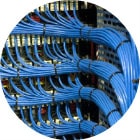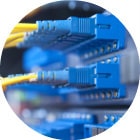In today’s fast-paced and technology-driven world, businesses rely heavily on their network infrastructure to ensure efficient communication and data transfer. This is where structured cabling comes into play. Structured cabling is the foundation of a reliable and efficient network, providing a structured and organized approach to designing and installing cabling systems.
Let’s explore the advantages of using structured cabling for your business.
1. Scalability
One of the most significant advantages of structured cabling is its scalability. Whether your business is just starting or expanding rapidly, structured cabling can easily adapt to your changing needs. It allows for the addition or removal of devices, such as computers, phones, or other network equipment, with minimal disruption. This scalability makes it a cost-effective solution for businesses of all sizes, ensuring that your cabling infrastructure can grow alongside your company.
2. Simplicity
Structured cabling provides a centralized and well-organized approach to network infrastructure. This makes it much easier to manage and maintain your cabling system. When all your cabling is neatly organized into structured and labeled components, it’s simpler to identify and resolve issues, as well as make upgrades or changes as needed. This streamlined management reduces downtime and minimizes the chances of human errors in cable identification.
3. Improved Performance
Structured cabling is designed to support high-speed data transfer and communication. This ensures that your network can handle the demands of modern business operations. With high-quality structured cabling, you can expect faster data transmission, lower latency, and improved overall network performance. Your employees can work more efficiently, and your customers will experience a smoother and more responsive service.
4. Enhanced Reliability
Reliability is paramount in business operations. Structured cabling systems are built to be highly reliable, reducing the risk of network downtime. Their design minimizes interference, cross-talk, and signal degradation. In the long run, this translates to fewer disruptions, improved customer satisfaction, and higher productivity for your workforce.
5. Future-Proofing
Investing in structured cabling is a future-proofing strategy. As technology advances, the demands on your network infrastructure will likely increase. Structured cabling can easily support emerging technologies and higher data transfer rates, ensuring your business can keep up with the ever-evolving IT landscape without requiring a complete infrastructure overhaul.
6. Cost Effective
While the initial investment in structured cabling may seem higher than traditional cabling solutions, the long-term cost savings are significant. You’ll spend less on maintenance, troubleshooting, and upgrades. The scalability of structured cabling also means that you won’t need to invest in a new cabling system each time your business expands or technology evolves. This results in a lower total cost of ownership over time.
7. Aesthetics and Safety
Structured cabling is not only practical but also aesthetically pleasing. A neatly organized cabling system contributes to a cleaner and more professional look in your workplace. Moreover, it reduces the risk of tripping hazards, ensuring the safety of your employees and visitors.
Structured cabling offers a multitude of advantages for businesses of all sizes. By choosing structured cabling, you’ll be laying a solid foundation for your network infrastructure that can support your business’s growth and technology needs for years to come.
Contact us today to discuss your challenges and build a strategy for simplicity and dependability.









